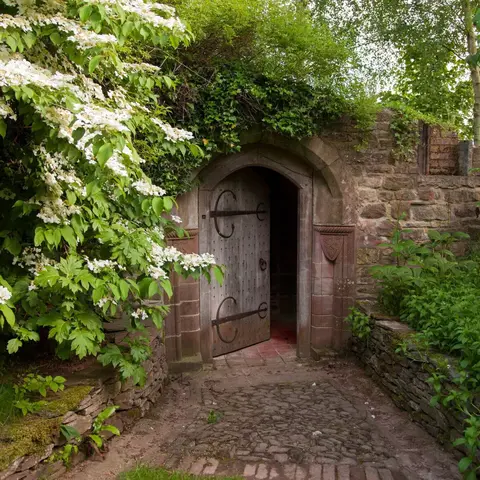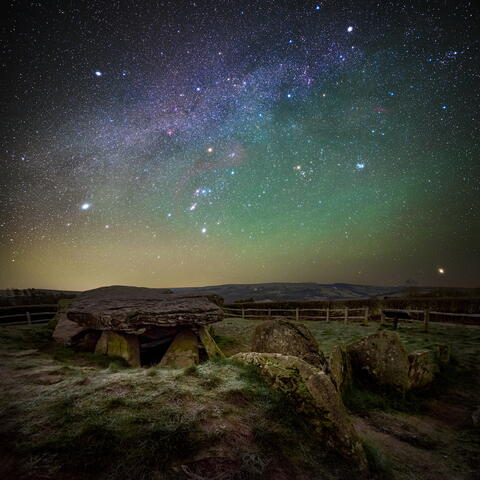Tracing the glorious Wye: Day Hike on the Herefordshire Trail
Little Dewchurch to Ross-on-Wye, 10 miles
We're celebrating the 20th anniversary of the Herefordshire Trail with a selection of do-able day hikes. By pairing a linear section of the trail with a local bus service, you can easily explore the many landscapes on offer across the county.
This walk keeps company with the river the Romans called Vaga ('wandering') via three historic bridges, starting in the rural hamlet of Little Dewchurch and finishing in the historic market town of Ross-on-Wye.
Heralded as the birthplace of English tourism, Ross-on-Wye was sought out by fans of ‘the picturesque’ - including Admiral Lord Nelson, Turner and Wordsworth - to enjoy boat excursions. Meanwhile, William Gilpin’s Observations on the River Wye (1792) was the first illustrated tour guide published in Britain.
This itinerary is based in Ross-on-Wye with its plentiful places to eat, drink and shop. A GPX file and OS map are available to view and download at the end of this article.
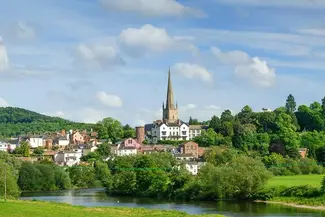
Base yourself in Ross-on-Wye
The charming market town of Ross-on-Wye is an excellent base for your mini adventure. Arrive the day before and check in to the characterful The King's Head Hotel which is a former coaching inn, The Royal Hotel which has a spectacular view of the Wye or the riverside Hope & Anchor.
Allow time for a mooch around the historic streets, touring the vintage shops and art galleries or pausing for a coffee at Truffles Deli, which is also a great place to pick up picnic provisions. Then visit The Prospect, a lookout point created by the "Man of Ross", the local philanthropist John Kyrle (1637–1724). It's a wonderful place to see the iconic view of the Wye's horsehoe bend.
To get closer to the river, wander down past pastel houses and through the fragrant terraced public garden to reach Wye Valley Walk. In the evening, sample the modern European menu at No 3.
Quote
How oft, in spirit, have I turned to thee
O sylvan Wye, thou wanderer thro’ the woods.
How often has my spirit turned to thee!
Head to Little Dewchurch
After a hearty breakfast, walk to Cantilupe Road (Stand 3) to catch the 9.35am bus (44 service) which runs Mondays to Saturdays. Alight at the village hall in Little Dewchurch at 9.59am.
On arrival in the hamlet, you can visit St David's Church. Set in a churchyard which is a nature conservation area, especially pretty in spring, it also features the remains of a medieval preaching cross and a 14th century tower. Inside, view the nave and chancel which were rebuilt in 1870 under the guidance of the renowned Victorian architect Frederick Preedy.
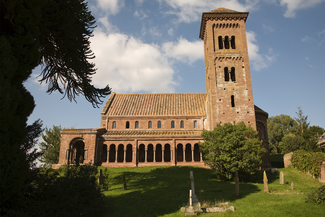
A Dash of the Mediterranean
Following the Herefordshire Trail, you will pass a modern landmark, Prothither Solar Farm, an extensive hilltop array of solar panels, to reach Hoarwithy.
Here the exotic Italianate Church of St. Catherine brings a dash of the Mediterranean to this Herefordshire valley. It is “an astonishing creation” by its Victorian architect, according to church buildings aficionado, Simon Jenkins.
In the village, the New Harp Inn is open lunchtimes Friday to Sunday, if you fancy stopping for a bite to eat.

Two River Crossings
Leaving the village, you'll cross the river at the Hoarwithy Toll Bridge, with the lofty former Toll House towering above the modern bridge. Hiking on, you will reach the elegant Sellack Boat Suspension Bridge. The footbridge was built in 1895 when local vicars were having trouble with ‘awkward’ ferrymen. One fed-up cleric is even said to have crossed the river on stilts!
In Sellack, it is a short detour to St Tysilio's Church, which features a Jacobean pulpit and musicians' gallery.
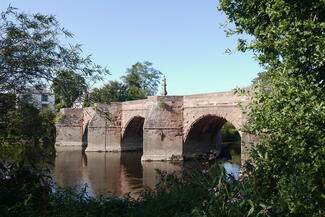
Returning to Ross
The next destination on your walk is the lovely six-arch red sandstone Wilton Bridge, completed in 1599 at one of the river’s most strategically important crossings, once protected by Wilton Castle.
The Norman fortress was reduced to ruins in the English Civil War. The bridge suffered the loss of one arch but successive generations kept up repairs to create a structure of distinction. In the 18th-century, it was graced by the addition of a multi-faced sundial on an ornate stone pillar. An inscription urges travellers to “esteem thy precious time.”
Follow the river to return to your base in Ross-on-Wye where a well-earned dinner awaits!
